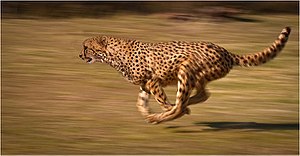
Pursuit predation is a form of predation in which predators actively give chase to their prey, either solitarily or as a group. It is an alternate predation strategy to ambush predation — pursuit predators rely on superior speed, endurance and/or teamwork to seize the prey, while ambush predators use concealment, luring, exploiting of surroundings and the element of surprise to capture the prey. While the two patterns of predation are not mutually exclusive, morphological differences in an organism's body plan can create an evolutionary bias favoring either type of predation.
Pursuit predation is typically observed in carnivorous species within the kingdom Animalia, such as cheetahs, lions, wolves and early Homo species. The chase can be initiated either by the predator, or by the prey if it is alerted to a predator's presence and attempt to flee before the predator gets close. The chase ends either when the predator successfully catches up and tackles the prey, or when the predator abandons the attempt after the prey outruns it and escapes.
One particular form of pursuit predation is persistence hunting, where the predator stalks the prey slowly but persistently to wear it down physically with fatigue or overheating; some animals are examples of both types of pursuit.